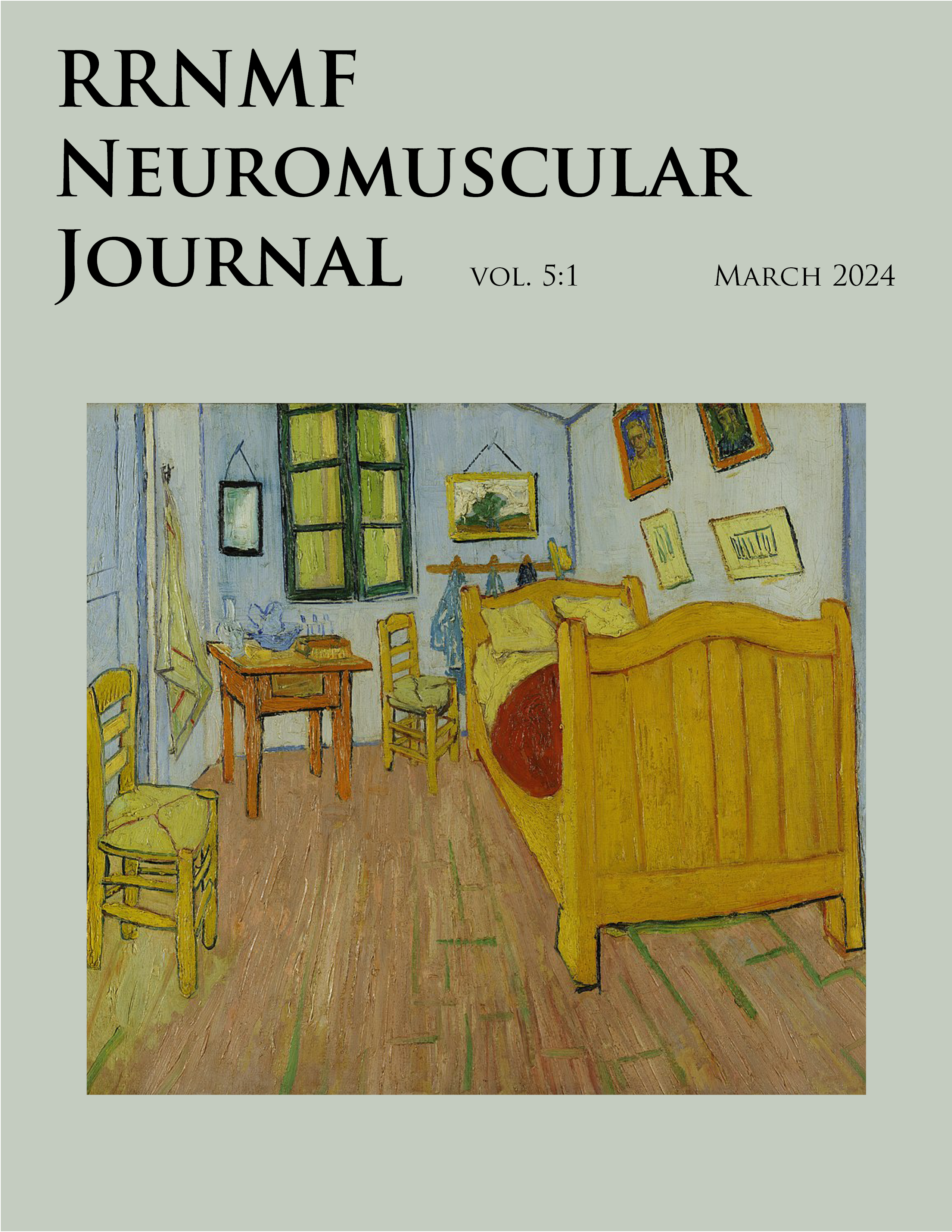Safety and tolerability of phenylbutyrate in inclusion body myositis
DOI:
https://doi.org/10.17161/rrnmf.v5i1.21356Keywords:
Inclusion body myositis, phenylbutyrateAbstract
Introduction
Phenylbutyrate (PBA) showed positive effect on the muscle cell model of Inclusion Body Myositis (IBM) by improving lysosomal activity, ameliorating consequences of impaired autophagy, and decreasing vacuolization. This provides rationale to study this medication in patients with IBM.
Objectives
To evaluate the safety and tolerability of phenylbutyrate in IBM, and monitor for any early signal of effectiveness.
Methods
Open-label study of 10 subjects with IBM who received treatment with PBA for 3 months after a 3-month run-in period. The PBA dose was 3 gm twice daily. The primary outcome measure was adverse event reporting. Secondary outcome measures included manual muscle testing, timed up and go test, IBM functional rating scale, and grip strength, along with exploratory biomarkers evaluating the mitochondrial function, stress response, degenerative process, and apoptosis.
Results
Ten subjects completed the study. PBA was well tolerated with no serious adverse events related to it. The most common adverse events were gastrointestinal related and did not require stopping treatment. One of the biomarkers (MitoTracker) showed a statistically significant drop over the treatment period of the study (p-value of 0.02 for the mean change). There were no statistically significant changes in other secondary outcome measures, but the study was limited by a small sample size and short treatment period.
Conclusions
Phenylbutyrate was safe and well tolerated in patients with IBM in this pilot study. The change in the MitoTracker suggests target engagement, but a Phase II study is needed to confirm and study the efficacy of PBA in IBM
Downloads
References
Felice KJ, North WA. Inclusion body myositis in Connecticut: observation in 35 patients during an 8-year period. Medicine (Baltimore) 2001:80:320-7
Wilson FC, Ytterberg SR, St Sauver JL, Reed AM. Epidemiology of sporadic inclusion body myositis and polymyositis and Olmsted County, Minnesota. J Rheumatol. 2008:35:445-7
Dimachkie MM, Barohn RJ. Inclusion body myositis. Curr Neurol Neurosci Rep. 2013;13:321
Machado PM, Dimachkie MM, Barohn RJ. Sporadic inclusion body myositis: new insights and potential therapy. Curr Opin Neurol. 2014 Oct;27(5):591-8.
Askanas V, Engel WK. Inclusion-body myositis: a myodegenerative conformational disorder associated with Abeta, protein misfolding, and proteasome inhibition. Neurology 2006;66(2 Suppl 1):S39-48
Nogalska A, D’Agostino C, Engel WK, Klein WL, Askanas V. Novel demonstration of amyloid-β oligomers in sporadic inclusion-body myositis muscle fibers. Acta Neuropathol 2010;120(5):661-6
Nogalska, A., D'Agostino, C., Terracciano, C., Engel, W.K., Askanas, V., 2010b. Impaired autophagy in sporadic inclusion-body myositis and in endoplasmic reticulum stress-provoked cultured human muscle fibers. Am. J. Pathol 2010;177:1377–1387
Nogalska A, D’Agostino C, Engel WK, Askanas V. Activation of the γ-secretase complex and presence of γ-secretase-activating protein may contribute to Aβ42 production in sporadic inclusion-body myositis muscle fibers. Neurobiol Dis. 2012;48(1):141-9
Forloni G, Terreni L, Bertani I et al. Protein misfolding in Alzheimer's and Parkinson's disease: genetics and molecular mechanisms. Neurobiol Aging. 2002;23:957-976
Hartl F, Hayer-Hartl M. Molecular chaperones in the cytosol: from nacent chain to folded protein. Science. 2002;295:1852-1858
Sherman MY, Goldberg AL. Cellular defenses against unfolded proteins: a cell biologist thinks about neurodegenerative diseases. Neuron 2001; 29(1): 15-32.
Papp E, Csermely P. Chemical chaperones: Mechanisms of action and potential use. Handb Exp Pharmacol 2006;172:405-16
Nogalska A, D’Agostino C, Engel K.W, Askanas V. Sodium phenylbutyrate reverses lysosomal dysfunction and decreases amyloid-β42 in an in vitro model of inclusion-body myositis, Neurobiol. Dis 2014;65:93-101
Downloads
Published
Issue
Section
License
Copyright (c) 2024 Duaa Jabari, Andrew Heim, Ali Ciersdorff, Heather Wilkins, Abdulbaki Agbas, Edina Kosa, Suzanne Hunt, Mamatha Pasnoor, Mazen Dimachkie, Richard Barohn

This work is licensed under a Creative Commons Attribution-NonCommercial-NoDerivatives 4.0 International License.

